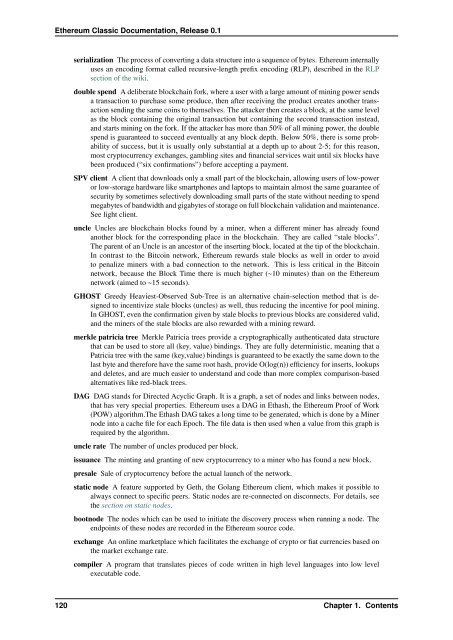Whitepaper - Ethereum Classic With Cover
Create successful ePaper yourself
Turn your PDF publications into a flip-book with our unique Google optimized e-Paper software.
<strong>Ethereum</strong> <strong>Classic</strong> Documentation, Release 0.1<br />
serialization The process of converting a data structure into a sequence of bytes. <strong>Ethereum</strong> internally<br />
uses an encoding format called recursive-length prefix encoding (RLP), described in the RLP<br />
section of the wiki.<br />
double spend A deliberate blockchain fork, where a user with a large amount of mining power sends<br />
a transaction to purchase some produce, then after receiving the product creates another transaction<br />
sending the same coins to themselves. The attacker then creates a block, at the same level<br />
as the block containing the original transaction but containing the second transaction instead,<br />
and starts mining on the fork. If the attacker has more than 50% of all mining power, the double<br />
spend is guaranteed to succeed eventually at any block depth. Below 50%, there is some probability<br />
of success, but it is usually only substantial at a depth up to about 2-5; for this reason,<br />
most cryptocurrency exchanges, gambling sites and financial services wait until six blocks have<br />
been produced (“six confirmations”) before accepting a payment.<br />
SPV client A client that downloads only a small part of the blockchain, allowing users of low-power<br />
or low-storage hardware like smartphones and laptops to maintain almost the same guarantee of<br />
security by sometimes selectively downloading small parts of the state without needing to spend<br />
megabytes of bandwidth and gigabytes of storage on full blockchain validation and maintenance.<br />
See light client.<br />
uncle Uncles are blockchain blocks found by a miner, when a different miner has already found<br />
another block for the corresponding place in the blockchain. They are called “stale blocks”.<br />
The parent of an Uncle is an ancestor of the inserting block, located at the tip of the blockchain.<br />
In contrast to the Bitcoin network, <strong>Ethereum</strong> rewards stale blocks as well in order to avoid<br />
to penalize miners with a bad connection to the network. This is less critical in the Bitcoin<br />
network, because the Block Time there is much higher (~10 minutes) than on the <strong>Ethereum</strong><br />
network (aimed to ~15 seconds).<br />
GHOST Greedy Heaviest-Observed Sub-Tree is an alternative chain-selection method that is designed<br />
to incentivize stale blocks (uncles) as well, thus reducing the incentive for pool mining.<br />
In GHOST, even the confirmation given by stale blocks to previous blocks are considered valid,<br />
and the miners of the stale blocks are also rewarded with a mining reward.<br />
merkle patricia tree Merkle Patricia trees provide a cryptographically authenticated data structure<br />
that can be used to store all (key, value) bindings. They are fully deterministic, meaning that a<br />
Patricia tree with the same (key,value) bindings is guaranteed to be exactly the same down to the<br />
last byte and therefore have the same root hash, provide O(log(n)) efficiency for inserts, lookups<br />
and deletes, and are much easier to understand and code than more complex comparison-based<br />
alternatives like red-black trees.<br />
DAG DAG stands for Directed Acyclic Graph. It is a graph, a set of nodes and links between nodes,<br />
that has very special properties. <strong>Ethereum</strong> uses a DAG in Ethash, the <strong>Ethereum</strong> Proof of Work<br />
(POW) algorithm.The Ethash DAG takes a long time to be generated, which is done by a Miner<br />
node into a cache file for each Epoch. The file data is then used when a value from this graph is<br />
required by the algorithm.<br />
uncle rate The number of uncles produced per block.<br />
issuance The minting and granting of new cryptocurrency to a miner who has found a new block.<br />
presale Sale of cryptocurrency before the actual launch of the network.<br />
static node A feature supported by Geth, the Golang <strong>Ethereum</strong> client, which makes it possible to<br />
always connect to specific peers. Static nodes are re-connected on disconnects. For details, see<br />
the section on static nodes.<br />
bootnode The nodes which can be used to initiate the discovery process when running a node. The<br />
endpoints of these nodes are recorded in the <strong>Ethereum</strong> source code.<br />
exchange An online marketplace which facilitates the exchange of crypto or fiat currencies based on<br />
the market exchange rate.<br />
compiler A program that translates pieces of code written in high level languages into low level<br />
executable code.<br />
120 Chapter 1. Contents
















